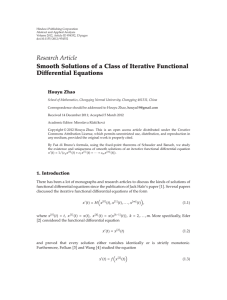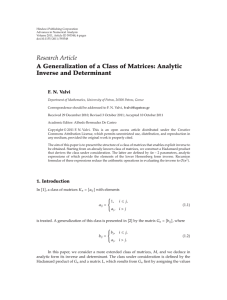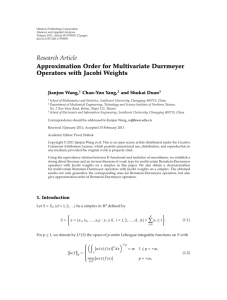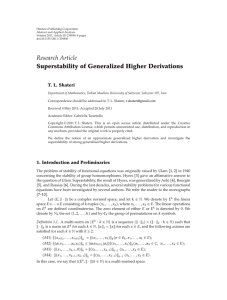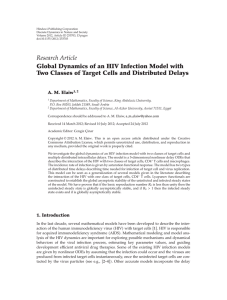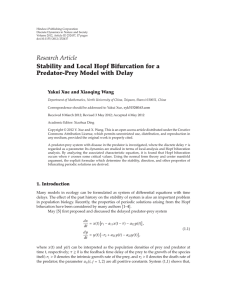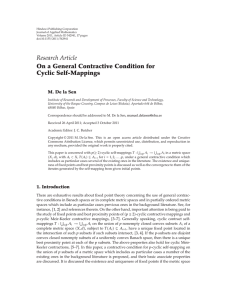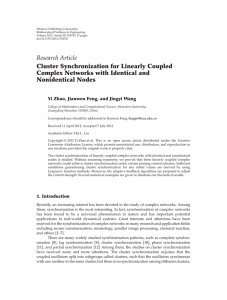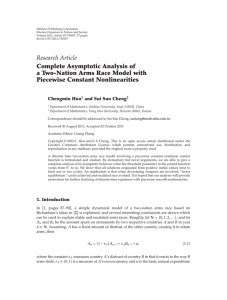Document 10850844
advertisement
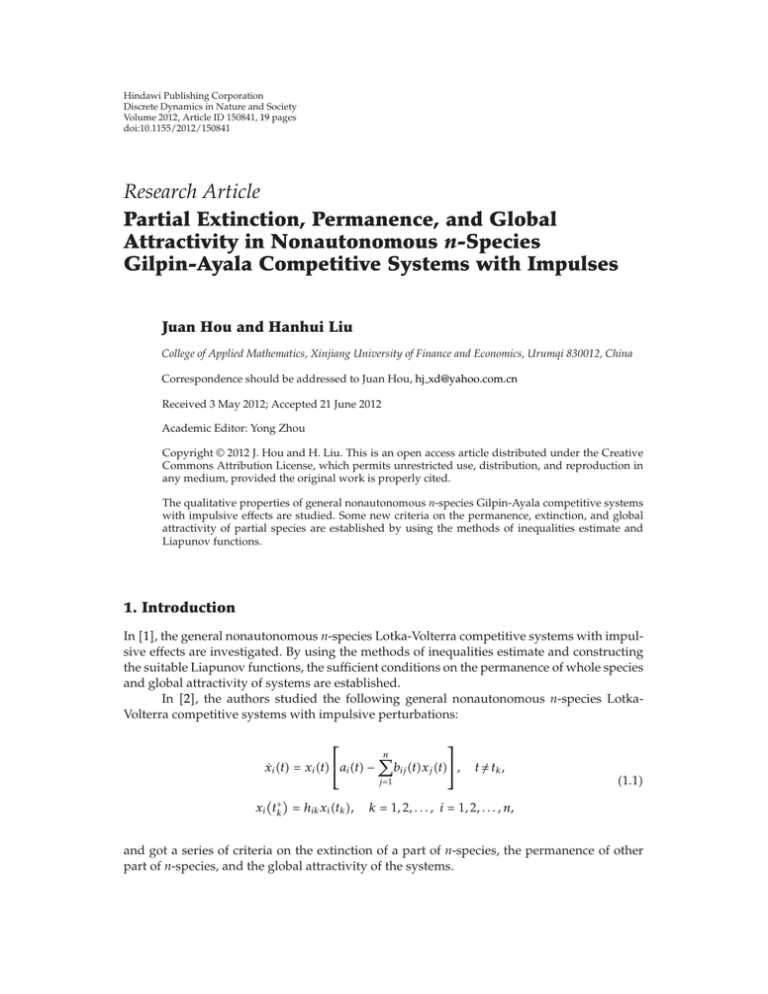
Hindawi Publishing Corporation
Discrete Dynamics in Nature and Society
Volume 2012, Article ID 150841, 19 pages
doi:10.1155/2012/150841
Research Article
Partial Extinction, Permanence, and Global
Attractivity in Nonautonomous n-Species
Gilpin-Ayala Competitive Systems with Impulses
Juan Hou and Hanhui Liu
College of Applied Mathematics, Xinjiang University of Finance and Economics, Urumqi 830012, China
Correspondence should be addressed to Juan Hou, hj xd@yahoo.com.cn
Received 3 May 2012; Accepted 21 June 2012
Academic Editor: Yong Zhou
Copyright q 2012 J. Hou and H. Liu. This is an open access article distributed under the Creative
Commons Attribution License, which permits unrestricted use, distribution, and reproduction in
any medium, provided the original work is properly cited.
The qualitative properties of general nonautonomous n-species Gilpin-Ayala competitive systems
with impulsive effects are studied. Some new criteria on the permanence, extinction, and global
attractivity of partial species are established by using the methods of inequalities estimate and
Liapunov functions.
1. Introduction
In 1, the general nonautonomous n-species Lotka-Volterra competitive systems with impulsive effects are investigated. By using the methods of inequalities estimate and constructing
the suitable Liapunov functions, the sufficient conditions on the permanence of whole species
and global attractivity of systems are established.
In 2, the authors studied the following general nonautonomous n-species LotkaVolterra competitive systems with impulsive perturbations:
⎡
⎤
n
ẋi t xi t⎣ai t − bij txj t⎦,
t
/ tk ,
j1
xi tk hik xi tk ,
1.1
k 1, 2, . . . , i 1, 2, . . . , n,
and got a series of criteria on the extinction of a part of n-species, the permanence of other
part of n-species, and the global attractivity of the systems.
2
Discrete Dynamics in Nature and Society
In 3, a periodic n-species Gilpin-Ayala competition system with impulses is studied
and obtain some useful behaviors of the system.
In this paper, we investigate the general nonautonomous n-species Gilpin-Ayala
competitive systems with impulsive effects.
⎡
⎤
n
θij
ẋi t xi t⎣ai t − bij txj t⎦,
t/
tk ,
1.2
j1
xi tk hik xi tk ,
k 1, 2, . . . , i 1, 2, . . . , n,
where bi t and aij t i, j 1, 2, . . . , n are defined on R 0, ∞ and are bounded
continuous functions, aij t ≥ 0 for all t ∈ R , θij and hik > 0 are constants for all k 1, 2, . . .
and i, j 1, 2, . . . , n.
2. Preliminaries
Firstly, we introduce the following assumption.
Assumption H. There is a positive constant ω such that for each i 1, 2, . . . , n
tω
lim inf
t→∞
⎛
tω
bi sds lim inf⎝
aii sds > 0,
t→∞
t
⎞
ln hik ⎠ > 0,
2.1
ttk tμ
t
and functions
hi t, μ ln hik ,
i 1, 2, . . . , n
ttk tμ
2.2
are bounded on t ∈ R and 0 μ ω.
For each i ∈ {1, 2, . . . , n}, we consider the following logistic impulsive equation as the
subsystem of system 1.2
ẋi t xi t bi t − aii txiθii t , t / tk ,
xi tk hik xi tk , k 1, 2, . . . .
From the above assumption, we have the following results.
2.3
Discrete Dynamics in Nature and Society
3
Lemma 2.1. Suppose that assumption H holds. Then we have the following:
1 There exist positive constants m and M such that
m lim inf xi t lim sup xi t M,
t→∞
2.4
t→∞
for any positive solution ui t of 2.3.
1
2
1
2
2 limt → ∞ xi t − xi t 0 for any two positive solutions xi t and xi t of 2.3.
Proof. From assumption H, there are positive constants k1 , k2 , δ and T0 such that for all t T0
we have
tω
bi s − aii sk1 ds t
ln hk < −δ,
2.5
ln hk > δ.
2.6
t≤tk <tω
tω
bi s − aii sk2 ds t
t≤tk <tω
From the boundedness of function ht, μ that for any t ∈ R and μ ∈ 0, ω
t≤tk <tμ
ln hk , there is a positive constant P such
h t, μ ln
h
k < P.
t≤tk <tμ
2.7
Firstly, we prove that there is a constant M > 0 such that
lim sup xi t < M,
2.8
t→∞
for any positive solution xi t of system 2.3. In fact, for any positive solution xi t of system
2.3, we only need to consider the following three cases.
Case I. There is a t0 ≥ T0 such that xt ≥ k1 k1 for all t ≥ t0 .
θii
Case II. There is a t0 ≥ T0 such that xt ≤ k1 for all t ≥ t0 .
Case III. xt is oscillatory about k1 for all t ≥ T0 .
4
Discrete Dynamics in Nature and Society
We first consider Case I. Since xi t ≥ k1 for all t ≥ t0 , then for t t0 lω, where l ≥ 0 is
any positive integer, integrating system 2.3 from t0 to t, from 2.5 we have
xi t xi t0 exp
t
bi s −
t0
⎛
≤ xi t0 exp⎝
t0 ω
aii sxiθii s
ds ln hk
t0 ≤tk <t
bi s − aii sk1 ds ln hk · · ·
t0 ≤tk <t
t0
t0 lω
t0 l−1ω
bi s − aii sk1 ds 2.9
⎞
ln hk ⎠
t0 l−1ω≤tk <t0 lω
≤ xi t0 exp−lδ.
Hence, xi t → 0 as l → ∞, which leads a contradiction.
Next, we consider Case III. From the oscillation of xi t about k1 , we can choose two
sequences {ρn } and {ρn∗ } satisfying T0 < ρ1 < ρ1∗ < · · · < ρn < ρn∗ < · · · and limn → ∞ ρn limn → ∞ ρn∗ ∞ such that
xi ρn ≤ k1 ,
xi ρn ≥ k1 ,
xi t ≥ k1 ,
xi t ≤ k1 ,
xi ρn∗ ≥ k1 ,
xi ρn∗ ≤ k1 ,
∀t ∈ ρn , ρn∗ ,
2.10
∀t ∈ ρn∗ , ρn1 .
For any t ≥ T0 , if t ∈ ρn , ρn∗ for some integer n, then we can choose integer l ≥ 0 and constant
0 ≤ μ1 < ω such that t ρn lω μ1 . Since
ẋi t ≤ xi tbi t − aii tk1 ,
∀t ∈ ρn , ρn∗ , t /
tk ,
2.11
Discrete Dynamics in Nature and Society
5
integrating this inequality from ρn to t, by 2.5 and 2.7 we obtain
xi t xi ρn
⎞
⎛
t bi s − aii sxθii s ds ln hk ⎠
exp⎝
ρn ≤tk <t
ρn
⎛
≤
k1
exp⎝
ρn ω
ln hk · · ·
ρn ≤tk <ρn ω
ρn
bi s − aii sk1 ds ρn lωμ1
ρn lω
⎛
≤ k1 exp⎝−lδ ⎞
bi s − aii sk1 ds ln hk ⎠
2.12
ρn lω≤tk <ρn lωμ1
ρn lωμ1
ρn lω
bi s − aii sk1 ds ⎞
ln hk ⎠
ρn lω≤tk <ρn lωμ1
≤ k1 expα1 ω P ,
where α1 supt∈R {|bi t| aii tk1 }. If there is an integer n such that t ∈ ρn∗ , ρn1 , then we
obviously have
xi t ≤ k1 < k1 expα1 ω P .
2.13
Therefore, for Case III we always have
xi t ≤ k1 expα1 ω P ,
∀t ≥ T0 .
2.14
∀t ≥ T0 .
2.15
Lastly, if Case II holds, then we directly have
xi t ≤ k1 expα1 ω P ,
Choose constant M k1 expα1 ω P , then we see that 2.8 holds.
Secondly, a similar argument as in the proof of 2.8 we can prove that there is a
constant m > 0, such that
2.16
lim inf xt > m,
t→∞
for any positive solution xi t of system 2.3. Conclusion 1.1 is proved.
1
2
Now, we prove conclusion 1.2. Let xi t and xi t be any two positive solutions of
system 2.3. From conclusion 1.1, it follows that there are positive constants A and B such
that
1
A xi t,
2
xi t B,
∀t ≥ 0.
2.17
6
Discrete Dynamics in Nature and Society
Choose Liapunov function as follows:
1
2
V t ln xi t − ln xi t.
2.18
1
2
V tk ln hk xi tk − ln hk xi tk V tk .
2.19
For any k 1, 2, . . ., we have
Hence, V t is continuous for all t ∈ R and from the Mean-Value Theorem we can obtain
1 1
1 1
2
2
xi t − xi t V t xi t − xi t.
B
A
2.20
Calculating the upper right derivative of V t, then from 2.20 we obtain
D V sign
1
xi t
−
2
xi t
1
ẋi t
1
xi t
1θ
2θ
− aii txi ii t − xi ii t
1
2
≤ − aii tθii Aθii xi t − xi t
≤ − aii tθii Aθii V t,
2
−
ẋi t
2
xi t
2.21
t/
tk , k 1, 2, . . . ,
where θii ≤ θii is the integer part of θii .
From this, we further have for any t > 0
V t V 0 exp −θii A
θii
t
aii sds .
2.22
0
From condition 2.5 we can obtain
t
0
aii tdt → ∞ as t → ∞. Hence, V t → 0 as t → ∞.
1
2
Further from 2.20 we finally obtain limt → ∞ xi t − xi t 0. Conclusion 1.2 is proved.
This completes the proof of Lemma 2.1.
Applying Lemma 2.1 and the comparison theorem of impulsive differential equations,
we easily prove the following result.
Lemma 2.2. Suppose that assumption H holds then there is a constant B > 0 such that
lim sup xi t ≤ B,
t→∞
i 1, 2, . . . , n,
for any positive solution xt x1 t, x2 t, . . . , xn t of system 1.2.
2.23
Discrete Dynamics in Nature and Society
7
3. Extinction
On the partial extinction of system 1.2, we have the following result.
Theorem 3.1. Suppose that assumption H holds. Let r be a given integer and 1 ≤ r < n. If for any
l > r there is a il < l such that for any j ≤ l
θil j θlj ,
tω
t
lim sup tω
t→∞
t
bl sds bil sds 3.1
ttk <tω
ln hlk
ttk <tω
ln hil k
< lim inf
alj t
,
ail j t
∀j ≤ l,
3.2
> lim sup
ail j t
,
alj t
∀j ≤ l,
3.3
t→∞
or
tω
lim inf t tω
t→∞
t
bil sds bl sds ttk <tω
ln hil k
ttk <tω
ln hlk
t→∞
then species xi i r 1, r 2, . . . , n are extinction, that is, for any positive solution xt x1 t, x2 t, . . . , xn t of system 1.2,
lim xi t 0,
i r 1, r 2, . . . , n.
t→∞
3.4
Proof. Firstly, from assumption H, that 2.7 still holds and there are constants η0 > 0 and
T0 > 0 such that
tω
bi sds t
ln hik ≥ η0 ,
3.5
ttk <tω
for all t ≥ T0 and i 1, 2, . . . , n.
We first prove xn t → 0 as t → ∞. Without loss of generality, we assume that
condition 3.2 holds. When condition 3.3 holds, a similar argument can be given. Since
tω
lim sup ttω
t→∞
t
bn sds bp sds ttk <tω
ttk <tω
ln hnk
ln hpk
< lim inf
t→∞
anj t
,
apj t
j 1, 2, . . . , n,
3.6
where p in . Hence, we can choose positive constants α, β, ε and Tn ≥ T0 such that
tω
t
tω
t
bn sds bp sds ttk <tω
ln hnk
ttk <tω
ln hpk
<
α anj t
α
−ε < <
,
β
β apj t
3.7
8
Discrete Dynamics in Nature and Society
for all t ≥ Tn and j 1, 2, . . . , n. Hence, from 3.5 we further obtain
tω
ln hnk − α
ln hpk
−αbp s βbn s ds β
t
< −βε
tω
t≤tk <tω
bp sds t
t≤tk <tω
3.8
ln hpk
t≤tk <tω
≤ −βεη0 ,
αapj t − βanj t βapj
α anj t
−
< 0,
β apj t
3.9
for all t ≥ Tn and j 1, 2, . . . , n.
Consider the Liapunov function as follows:
−α
Vn t xp t xn tβ .
3.10
Calculating the derivative, and from 3.1, we can obtain for any t ≥ 0
⎛
⎞
⎞⎤
⎡ ⎛
n
n
dVn t
θpj
θnj
Vn t⎣−α⎝bp t − apj txj t⎠ β⎝bn t − anj txj t⎠⎦
dt
j1
j1
⎡
Vn t⎣−αbp t βbn t n
⎤
3.11
θpj
αapj t − βanj t xj t⎦,
j1
for all t / tk and
β
Vn tk h−α
pk hnk Vn tk ,
3.12
for all k 1, 2, . . .. From 3.9, we further have
dVn t
≤ Vn t −αbp t βbn t , t ≥ Tn , t /
tk ,
dt
β
Vn tk h−α
k 1, 2, . . . .
pk hnk Vn tk ,
3.13
Discrete Dynamics in Nature and Society
9
For any t > Tn , there is an integer qt ≥ 0 such that t ∈ Tn qt ω, Tn qt 1ω. Hence, by
integrating 3.13 from Tn to t, we obtain
Vn t ≤ Vn Tn exp
t
−αbp s βbn s ds Tn ≤tk <t
Tn
β
ln h−α
pk hnk
⎧
⎨ Tn ω Vn Tn exp
−αbp s βbn s ds
⎩ Tn
Tn ≤tk <Tn ω
Tn qt ω≤tk
t
β
·
·
·
ln h−α
h
pk nk
Tn qt ω
−αbp s βbn s ds
3.14
⎫
⎬
β
ln h−α
pk hnk ⎭
<t
≤ Mn exp −εβη0 qt ,
where
# " Mn Vn Tn exp ω sup αbp t β|bn t| α β P
.
3.15
t≥0
Since qt → ∞ as t → ∞, it follows that from 3.14
Vn t −→ 0 as t −→ ∞.
3.16
Since
α
xn tβ Vn t xp t ,
β
hnk xn tk β hαpk xp tk h−α
pk hnk Vn tk ,
3.17
by the boundedness of xt on 0, ∞ see Lemma 2.2, we have
xn t −→ 0 as t −→ ∞.
3.18
10
Discrete Dynamics in Nature and Society
For any integer l > r, assume that we have obtained xi t → 0 as t → ∞ for all i > l.
Now, we prove that xl t → 0 as t → ∞. Suppose that condition 3.3 holds. When condition
3.2 holds, the argument is similar. Let i il , by 3.1, we have θil j θlj , then for j ≤ l, we
have θij θlj . Then we can choose positive constants λ, η, δ and Tl ≥ T0 such that
tω
t
bq sds t
bl sds tω
ttk <tω
ln hqk
ttk <tω
ln hlk
>
λ aqj t
λ
δ > >
,
η
η alj t
3.19
for all t ≥ Tl , and j 1, 2, . . . , l, where q il .
Consider the Liapunov function as follows:
−η
Vl t xq t xl tλ .
3.20
By calculating, we obtain for any t ≥ 0
⎡
l
θlj
dVl t
Vl t⎣−ηbq t λbl t ηaqj t − λalj t xj t
dt
j1
n
θqj
ηaqj txj t −
jl1
n
⎤
3.21
θlj
λalj txj t⎦,
jl1
for all t / tk and
−η
Vl tk hqk hλlk Vl tk ,
3.22
for all k 1, 2, . . .. From 3.3 and 3.19, we have
tω
ln hlk − η
ln hqk
−ηbq s λbl s ds λ
t
< −ηδ
tω
t
t≤tk <tω
bl sds ln hlk
t≤tk <tω
3.23
t≤tk <tω
≤ −δηη0 ,
ηaqj t − λalj t < 0,
3.24
Discrete Dynamics in Nature and Society
11
for all t ≥ Tl and j 1, 2, . . . , l. Hence, from 3.21, it follows that
l θlj
dVl t
≤ Vl t −ηbq t λbl t ηaqj t − λalj t xj t
dt
j1
n
n
θqj
θlj
ηaqj txj t −
λalj txj t , t ≥ Tl , t /
tk ,
jl1
3.25
jl1
β
Vn tk h−α
pk hnk Vn tk ,
k 1, 2, . . . .
Since xi t → 0 as t → ∞ for all i > l, by the boundedness of aij t i, j 1, 2, . . . , n
on 0, ∞, we obtain
lim
tω n t→∞
t
θ
θqj
lj
ηaqj sxj s − λalj s xj sds 0.
3.26
jl1
Hence, for any small ε > 0, there is a Tl > 0, such that
tω n t
θ
θqj
lj
ηaqj sxj s − λalj s xj sds < ε,
t > Tl .
3.27
jl1
Combining 3.23, it follows that there is enough large Tl∗ > max{Tl , Tl } such that for
all t ≥ Tl∗ ,
tω
t
−ηbq s λbl s −η
t≤tk <tω
n
jl1
θqj
ηaqj sxj s
n
−
xi t ≤ δ
∀i > l.
λalj s
jl1
1
ln hlk ≤ − δηη0 ,
2
t≤tk <tω
ln hqk λ
θlj
xj s
ds
3.28
12
Discrete Dynamics in Nature and Society
For any t > Tl∗ , we firstly choose an integer qt ≥ 0 such that t ∈ Tl∗ qt ω, Tl∗ qt 1ω.
Integrating 3.25 from Tl∗ to t, then from 3.3 and 3.28, we have
∗
Vl t ≤ Vl Tl
⎧ ⎡
⎞
⎛
⎤
n
n
⎨ t
θqj
θlj
⎝ηaqj sx s −
⎣−ηbq s λbl s λalj s⎠xj s⎦ds
exp
j
⎩ T∗
jl1
jl1
l
∗
Vl Tl
⎫
−η ⎬
ln hqk hλlk
⎭
<t
Tl∗ ≤tk
⎧⎛
⎤
⎡
n
n
⎨ Tl∗ ω
θqj
θlj
⎣−ηbq s λbl s ηaqj sxj s −
λalj sxj s⎦ds
exp ⎝
⎩
T∗
jl1
jl1
l
Tl∗ ≤tk <Tl∗ ω
⎞
−η ln hqk hλlk ⎠ · · ·
⎛
⎡
T ∗ qt ω
n
l
θqj
⎣−ηbq s λbl s ⎝
ηaqj sxj s
∗
Tl qt −1ω
jl1
⎞
⎤
n
−η θlj
λ
−
λalj sxj s⎦ds
ln hqk hlk ⎠
∗
∗
jl1
Tl qt −1ω≤tk <Tl qt ω
⎛
⎡
t
n
θqj
⎝
⎣−ηbq s λbl s ηaqj sxj s
Tl∗ qt ω
jl1
n
⎤
θlj
−
λalj sxj s⎦ds
jl1
$
%
1
≤ Ml exp − δηη0 qt ,
2
Tl∗ qt ω≤tk <t
ln
−η
hqk hλlk
⎞⎫
⎬
⎠
⎭
3.29
where
∗
Ml Vl Tl
⎧
⎫
⎧⎛
⎞⎫
n
⎨ ⎬
⎨
θlj ⎬ λ η P⎠ ,
exp ⎝ωsup ηbq t λ|bl t| ηaqj t λalj t δ
⎭
⎭
⎩
t≥0 ⎩
jl1
3.30
Since qt → ∞ as t → ∞, we obtain from 3.29
Vl t −→ 0 as t −→ ∞,
3.31
Discrete Dynamics in Nature and Society
13
Since
λ
xl tη Vl t xq t ,
η
hlk xl tk 3.32
λ
η
hlk h−λ
qk Vl tk hqk xq tk ,
by the boundedness of xt on 0, ∞, it follows that
xl t −→ 0
as t −→ ∞.
3.33
Finally, by the induction principle, we obtain that xi t → 0 as t → ∞ for all i > r. This
completes the proof of Theorem 3.1.
4. Permanence
In this section, we study the permanence of partial species xi t i 1, 2, . . . , r of system
1.2. We state and prove the following result.
Theorem 4.1. Suppose that all the conditions of Theorem 3.1 hold. If for each i 1, 2, . . . , r
⎛
lim inf⎝
t→∞
tω
⎡
⎣bi s −
r
j/
i
t
⎤
θij
aij suj0 t⎦ds ⎞
ln hik ⎠ > 0,
4.1
t≤tk <tω
where ui0 is some fixed positive solution of 2.3, then species xi i 1, 2, . . . , r are permanent,
that is, there are positive constants m and M such that for any positive solution xt x1 t, x2 t, . . . , xn t of system 1.2
m ≤ lim infxi t ≤ lim supxi t ≤ M,
t→∞
t→∞
i 1, 2, . . . , r.
4.2
14
Discrete Dynamics in Nature and Society
Proof. From 4.1 and the boundedness of functions aij t i, j 1, 2, . . . , n on R , there are
constants ε0 > 0 and T1 > 0 such that for any t ≥ T1 and i 1, 2, . . . , r.
tω
t
⎡
⎣bi s −
n
⎤
r
θij
aij sε0 − aij suj0 s⎦ds j/
i
j1
ln hik > ε0 .
4.3
t≤tk <tω
For any i ≤ r, from system 1.2, we have
⎡
dxi t
≤ xi t⎣bi t −
dt
n
⎤
θij
aij txj t⎦,
j1
≤ xi t ai t − bii txiθii t ,
xi tk hik xi tk ,
t/
tk , t ≥ 0,
4.4
k 1, 2, . . . ,
we have
xi t ≤ ui t
∀t ≥ 0,
4.5
where ui t is the solution of 2.3 with initial condition ui 0 ≥ xi 0. From Lemma 2.1 and
Theorem 3.1, for the above constant ε0 there is a T2 ≥ T1 such that for all t ≥ T2
xi t ≤ ui t ≤ ui0 t ε0 ,
xi t < ε0 ,
i 1, 2, . . . , r,
4.6
i r 1, r 2, · · · , n.
4.7
Let
⎧
⎨
γi sup |bi t| t≥0 ⎩
n
j1
aij tε0 r
θij
⎫
⎬
aij tuj0 t ,
⎭
j i
/
4.8
#
"
m min ε0 exp −γi ω − P ,
1≤i≤r
where constant P > 0 is given in 2.7. Obviously, m > 0 and m is independent of any positive
solution of system 1.2.
Now, we prove that there is a T3 ≥ T2 such that
xi t ≥ m
∀t ≥ T3 , i 1, 2, . . . , r.
4.9
Discrete Dynamics in Nature and Society
15
We only need to consider the following three cases for each i 1, 2, . . . , r.
Case I. There is a t1 ≥ T2 such that xi t ≤ ε0 √
θii
ε0 for all t ≥ t1 .
Case II. There is a t2 ≥ T2 such that xi t ≥ ε0 for all t ≥ t2 .
Case III. xi t oscillates about ε0 for all t ≥ T2 .
For Case I, let t t1 lω, where l ≥ 0 is any integer. From 4.3–4.7 we obtain
⎛
xi t xi t1 exp⎝
⎛
t
⎝bi s − aii sxθii s −
i
t1
⎛
≥ xi t1 exp⎝
t1 ω
t1
j/
i
⎞
aij sxj s⎠ds θij
⎞
ln hik ⎠
t1 ≤tk <t
⎞
n
r
θij
⎝bi s − aij sε0 − aij su s⎠ds
j0
⎛
j/
i
j1
n
ln hik · · · t1 ≤tk <t1 ω
t1 l−1ω
⎝bi s −
n
⎞
r
θij
aij sε0 − aij suj0 s⎠ds
j
/i
j1
⎞
⎛
t1 lω
ln hik ⎠
t1 l−1ω≤tk <t1 lω
≥ xi t1 explε0 .
4.10
Therefore, xi t → ∞ as l → ∞ which leads to a contradiction.
For Case III, we choose two sequences {ρn } and {ρn∗ } satisfying T2 ≤ ρ1 < ρ1∗ < · · · <
∗
ρn < ρn < · · · and limn → ∞ ρn limn → ∞ ρn∗ ∞ such that
xi ρn ≥ ε0 ,
xi ρn ≤ ε0 ,
xi t ≤ ε0
xi t ≥ ε0
xi ρn∗ ≤ ε0 ,
xi ρn∗ ≥ ε0 ,
∀t ∈ ρn , ρn∗ ,
4.11
∀t ∈ ρn∗ , ρn1 .
For any t ≥ T2 , if t ∈ ρn , ρn∗ for some integer n, then we can choose an integer l ≥ 0 such that
t ρn lω νi , where νi ∈ 0, ω is a constant. Since for any t ∈ ρn , ρn∗ from 4.6 and 4.7
we have
⎛
ẋi t ≥ xi t⎝bi t −
n
j1
⎞
r
θij
aij tε0 − bij tuj0 t⎠,
j/
i
t
/ tk .
4.12
16
Discrete Dynamics in Nature and Society
Integrating this inequality from ρn to t, then from 4.7 and 3.28-3.29 we have
xi t ≥ x ρn
⎞
⎞
⎛ ⎛
t
n
r
θij
ln hik ⎠
exp⎝ ⎝bi s − aij sε0 − aij suj0 s⎠ds ρn
⎛
≥ ε0 exp⎝
ρn ω
ρn
⎞
n
r
θij
⎝bi s − aij sε0 − aij su s⎠ds
j0
⎛
ln hik · · · ρn ≤tk <ρn ω
ρn lω
ρn l−1ω
⎞
n
r
θij
⎝bi s − aij sε0 − aij su s⎠ds
j0
⎛
j/
i
j1
⎞
j/
i
j1
ρn ≤tk <t
j/
i
j1
ln hik ⎠
ρn l−1ω≤tk <ρn lω
ρn lωνi
ρn lω
⎛
⎝bi s −
n
j1
⎞
r
θij
aij sε0 − aij suj0 s⎠ds j/
i
ln hik
ρn lω≤tk <ρn lωνi
≥ ε0 exp −γi ω − P .
4.13
If there exists an integer n such that t ∈ ρn∗ , ρn1 , then we obviously have
xi t ≥ ε0 > ε0 exp −γi ω − P .
4.14
This shows that for Case III we always have
xi t ≥ ε0 exp −γi ω − P ,
∀t ≥ T2 .
4.15
Finally, if Case II holds, then from xi t ≥ ε0 for all t ≥ t1 , we can directly obtain that
4.9 holds.
Therefore, from Lemma 2.2 and 4.9, it follows that species xi t i 1, 2, . . . , r are
permanent. This proof of Theorem 4.1 is completed.
5. Global Attractivity
In this section, we further discuss the global attractivity of species xi t i ≤ r. In order to
obtain our results, we first consider the following subsystem which is composed of the species
Discrete Dynamics in Nature and Society
17
xi t i ≤ r of system 1.2 and for convenience of statement we use the variable ui t i ≤ r
to denote the species of this subsystem,
⎡
⎤
r
dui t
θij
ui t⎣bi t − aij tuj t⎦,
dt
j1
ui tk hik ui tk ,
t/
tk ,
5.1
i 1, 2, . . . , r, k 1, 2, . . . .
We need the following lemma.
Lemma 5.1. Suppose that assumption H and condition 4.1 of Theorem 4.1 hold. Then subsystem
5.1 is permanent.
Lemma 5.1 can be proved by using the same method given in the proof of Theorem 4.1. We now
state and prove the main result of this section.
Theorem 5.2. Suppose that all conditions of Theorem 3.1 and Theorem 4.1 hold. If there are positive
constants ρ, D and di i 1, 2, . . . , r and nonnegative integrable function μt defined on R ,
t
satisfying s μτdτ ≥ −D ρt − s for all t ≥ s ≥ 0, such that
di aii t −
r
dj aji t ≥ μt,
i 1, 2, . . . , r,
j/
i
5.2
for all t ≥ 0, then for any positive solution xt x1 t, x2 t, . . . , xn t of system 1.2 and any
positive solution ut u1 t, u2 t, . . . , ur t of subsystem 5.1
lim xi t − ui t 0,
t→∞
i 1, 2, . . . , r.
5.3
Proof. Let xt x1 t, x2 t, . . . , xn t be a positive solution of system 1.2 and ut u1 t, u2 t, . . . , ur t be a positive solution of subsystem 5.1. By Theorem 3.1, we have
xi t → 0 as t → ∞ for all i > r. From Theorem 4.1 and Lemma 5.1, there are positive
constants m and M such that
m ≤ xi t,
ui t ≤ M,
i 1, 2, . . . , r,
5.4
for all t ≥ 0. Choose the Liapunov function as follows:
Vr t r
di |ln xi t − ln ui t|.
i1
5.5
18
Discrete Dynamics in Nature and Society
Since
r
di ln xi tk − ln ui tk Vr tk i1
r
di |ln hik xi tk − ln hik ui tk |
5.6
i1
Vr tk ,
then V t is continuous for all t ≥ 0. Calculating the upper right derivative of Vr t, we have
⎞
⎛
r
r
θ
θij
ij
di ⎝−aii xiθii t − uθi ii t aij txj t − uj t⎠ gt
D Vr t ≤
j/
i
i1
⎞
⎛
r
r
θ
θji
ji
− ⎝di aii − dj aji t⎠xi t − ui t gt,
5.7
j/
i
i1
for all t ≥ 0, where
gt r
di
i1
n
θji
aji txj t.
5.8
jr1
By 5.2, we have
D Vr t ≤ −μt
r θji
θji
xi t − ui t gt,
∀t ≥ 0.
5.9
i1
By 5.4, we further obtain
D Vr t ≤ −λμtVr t gt,
∀t ≥ 0,
5.10
where λ min1≤i≤r di−1 m > 0. Applying the comparison theorem and the variation of constants
formula of first-order linear differential equation, we have
Vr t ≤ e
−
t
0
λμsds
t
gse
s
0
λμτdτ
ds Vr 0 ,
5.11
0
for all t ≥ 0. Since gt → 0 as t → ∞, from the properties of function μt and 5.11, it is
not hard to obtain Vr t → 0 as t → ∞. That shows
lim xi t − ui t 0,
t→∞
This completes the proof of Theorem 5.2.
i 1, 2, . . . , r.
5.12
Discrete Dynamics in Nature and Society
19
References
1 J. Hou, Z. Teng, and S. Gao, “Permanence and global stability for nonautonomous N-species LotkaValterra competitive system with impulses,” Nonlinear Analysis, vol. 11, no. 3, pp. 1882–1896, 2010.
2 J. Hou, Z. D. Teng, and S. J. Gao, “Partial extinction, permanence and global attractivity in
nonautonomous n-species Lotka-Volterra competitive systems with impulses,” Applied Mathematics:
A Journal of Chinese Universities, vol. 26, no. 2, pp. 161–176, 2011.
3 M. He, Z. Li, and F. Chen, “Permanence, extinction and global attractivity of the periodic Gilpin-Ayala
competition system with impulses,” Nonlinear Analysis, vol. 11, no. 3, pp. 1537–1551, 2010.
Advances in
Operations Research
Hindawi Publishing Corporation
http://www.hindawi.com
Volume 2014
Advances in
Decision Sciences
Hindawi Publishing Corporation
http://www.hindawi.com
Volume 2014
Mathematical Problems
in Engineering
Hindawi Publishing Corporation
http://www.hindawi.com
Volume 2014
Journal of
Algebra
Hindawi Publishing Corporation
http://www.hindawi.com
Probability and Statistics
Volume 2014
The Scientific
World Journal
Hindawi Publishing Corporation
http://www.hindawi.com
Hindawi Publishing Corporation
http://www.hindawi.com
Volume 2014
International Journal of
Differential Equations
Hindawi Publishing Corporation
http://www.hindawi.com
Volume 2014
Volume 2014
Submit your manuscripts at
http://www.hindawi.com
International Journal of
Advances in
Combinatorics
Hindawi Publishing Corporation
http://www.hindawi.com
Mathematical Physics
Hindawi Publishing Corporation
http://www.hindawi.com
Volume 2014
Journal of
Complex Analysis
Hindawi Publishing Corporation
http://www.hindawi.com
Volume 2014
International
Journal of
Mathematics and
Mathematical
Sciences
Journal of
Hindawi Publishing Corporation
http://www.hindawi.com
Stochastic Analysis
Abstract and
Applied Analysis
Hindawi Publishing Corporation
http://www.hindawi.com
Hindawi Publishing Corporation
http://www.hindawi.com
International Journal of
Mathematics
Volume 2014
Volume 2014
Discrete Dynamics in
Nature and Society
Volume 2014
Volume 2014
Journal of
Journal of
Discrete Mathematics
Journal of
Volume 2014
Hindawi Publishing Corporation
http://www.hindawi.com
Applied Mathematics
Journal of
Function Spaces
Hindawi Publishing Corporation
http://www.hindawi.com
Volume 2014
Hindawi Publishing Corporation
http://www.hindawi.com
Volume 2014
Hindawi Publishing Corporation
http://www.hindawi.com
Volume 2014
Optimization
Hindawi Publishing Corporation
http://www.hindawi.com
Volume 2014
Hindawi Publishing Corporation
http://www.hindawi.com
Volume 2014
